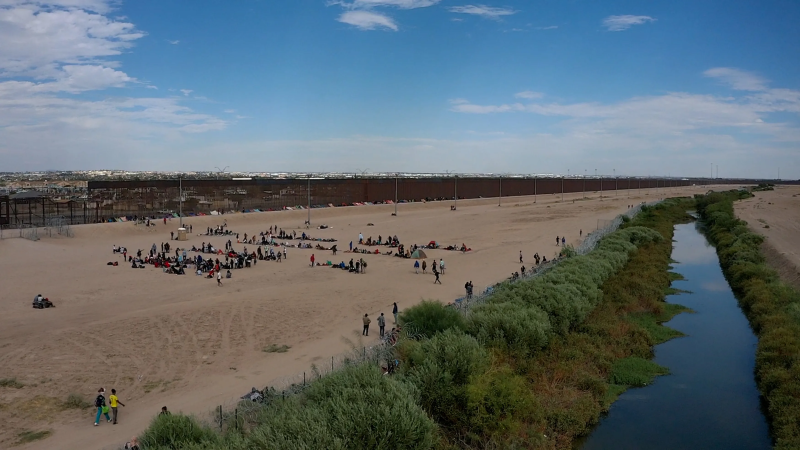Migrant deaths more than doubled in El Paso Sector after scorching heat, Border Patrol data says
EL PASO, Texas — Migrant deaths more than doubled this year along the U.S.-Mexico border in El Paso, Texas, reaching the heaviest toll the region has seen since public record-keeping began — 148, compared with 71 in 2022, according to U.S. Border Patrol data obtained by the El Paso Times, part of the USA TODAY Network.
The majority of the deaths — more than 100 — occurred between May and September, when El Paso experienced one of its hottest summers on record with 44 consecutive days of triple-digit heat, according to the National Weather Service. Many migrants crossing the border seek to improve their lives, find jobs, and places to seek refuge, be it in shelters, hotels, community centers, airports, bus stops, and even sidewalks, experts said.
The U.S.-Mexico border, nearly 2,000 miles across, is considered the deadliest land route for migrants worldwide, with 686 deaths and disappearances recorded last year, according to a report by the United Nation's International Organization for Migration. About half of those deaths were linked to hazardous crossing conditions in the Sonoran and Chihuahuan Deserts, which cross parts of California, Arizona, and Texas, according to the U.N. report.
The latest grim number comes after a wave of record-breaking heat across the Southwest. Heat and rising temperatures play a role in the number of migrant deaths, but researchers say those are only a couple of factors that play into the overall trends. The required physical exertion that migrants must undergo because of U.S. immigration policy changes also contributes to the number of heat-related migrant deaths.
'NEW NORMAL':High number of migrants crossing border not likely to slow
The deadliest route for migrants
The El Paso sector is expected to record its highest-ever number of migrant encounters this year, on pace to top 400,000 and beat last year's record of nearly 308,000 encounters, according to U.S. Customs and Border Protection statistics.
Border Patrol's El Paso Sector stretches from Hudspeth County in Texas across New Mexico to the Arizona state line. There are vast areas of desert in southern New Mexico, but by far the deadliest zone is centered around Sunland Park and Santa Teresa, in the desert hills outside El Paso's metropolitan footprint.
All summer, El Paso law enforcement agencies and first responders were called to coordinates near backyards and businesses, as people died seemingly within reach of rescue.
"It's not new, but it's a big topic and it's more numbers," said El Paso Sheriff's Office Cmdr. Robert Rojas. "Because it's not just Mexican nationals trying to cross; you have many different countries of origin. It's possible that they don't know the terrain, the climate, or what they are coming into."
Field investigators for New Mexico's Office of the Medical Examiner were called to Sunland Park and Santa Teresa as many as four times in one day, as border agents and even residents discovered bodies.
"When you are standing on the dirt, sometimes you don't see the city because of the mesquite mounds," said Sunland Park Fire Chief Danny Medrano. "We don't know if they are given bad directions or if they are hiding. It is difficult to see the city sometimes and you are only half a mile away."
'Recipe for death'
Deterrence policies and physical infrastructure, such as walls or barriers, will not stop people from trying to make the journey to the U.S., said Brad Jones, professor of political science with the University of California, Davis, and a volunteer with Arizona-based nonprofit Humane Borders.
Migrants will continue to feel compelled to make the journey as long as push factors in their home countries remain the same, Jones said. But the policies and barriers will force them to take more treacherous routes.
“That's just a recipe for death,” Jones said. “It's just going to make the journey that much more difficult.”
Increased border enforcement and policy changes "likely contributed" to the number of recovered migrant remains during the past 20 years, given that migrants increasingly are crossing the border through more remote and dangerous areas in order to avoid detection, according to a 2021 report by the University of Arizona's Binational Migration Institute.
Those trends can be traced back to the 1990s when the Border Patrol first implemented its “prevention through deterrence” policies. The policies were meant to push undocumented migrants to cross the border through more remote and dangerous areas instead of urban hubs like Tijuana-San Diego and Juarez-El Paso.
“What happens with hyper-enforcement is that asylum seekers or migrants are simply going to take greater risks and by greater risks, that means entering in more inhospitable areas,” Jones said.

Lauren Villagran can be reached at lvillagran@elpasotimes.com, @laurenvillagran on X and @fronteravillagran on Instagram.
Contributing: Terry Collins and Vanessa Arredondo, USA TODAY; José Ignacio Castañeda Perez, Arizona Republic
Disclaimer: The copyright of this article belongs to the original author. Reposting this article is solely for the purpose of information dissemination and does not constitute any investment advice. If there is any infringement, please contact us immediately. We will make corrections or deletions as necessary. Thank you.




